Developments in ball screw technology are giving you more options for linear motion. And many of these newer options challenge accepted assumptions of how and where to use a ball screw.
One classic assumption, for example, relegates low cost, rolled screws to low accuracy transport-type applications and more expensive precision ground screws to high accuracy needs. Today, though, rolled screws can deliver a lead accuracy of better than 0.001 in./ft. In addition, the price/performance ratio of these devices has plummeted by 50%, making them attractive options for many applications previously limited to high precision screws.
These developments stem from improvements in ball screw design, materials, and manufacturing processes. Better design is raising speed limits and lowering the cost of accuracy. Advances in materials processing ensure that each step of the metallurgical process produces the correct material composition for homogeneity and hardness. And changes in manufacturing, such as refined dies and heat treating methods, as well as closer control of all manufacturing processes, also contribute to the finer accuracies and revved-up speeds of ball screws.
Mapping precise control
From their design work, manufacturers can provide large amounts of data on screw performance. Control devices, such as a programmable controller (PLC) on a machine tool, can use these data to help lowaccuracy- grade ball screws achieve accuracies below one micron with near perfect repeatability.
The process starts with a designer mapping a screw's lead accuracy during manufacturing. At installation, this information is entered into the PLC. When the machine tool runs, the PLC uses the mapped data to immediately correct any manufacturing variables. Additional data is available to compensate for shaft windup or thermal expansion.
Such a feature expands the choices of ball screws for many applications, and simultaneously gives engineers greater control over costs. Some applications that use high-precision screws because that was the best choice at the time may work as well with a lowergrade- accuracy screw.
Moving out
The telescoping ball screw is an alternative for applications that can't handle the bulk of pneumatic or hydraulic systems. These "multi-extend" actuators use one ball-screw assembly within a hollow ball-screw assembly, often within another hollow ball-screw assembly. They can double, triple, or better their lengths. They have higher strengthto- weight ratios than standard ball screws because they weigh 70% as much, yet they have equal load capacity.
Extension speed varies, depending on the number of hollow screws in the assembly. Through right hand and left hand combinations, the screw can move twice as fast.
With a hole in the middle
Hollow ball screws save weight. But they offer other advantages.
Because of the low weight, a hollow screw with the same diameter and lead of a standard screw can operate at speeds as much as 27% faster without reaching critical speed. With its lower rotational inertia, response time is quicker than with standard screws, as is settling time. Column loading is also increased. These features are desirable in precise positioning applications.
A hollow screw can also function as a conduit for coolant during operation or to hold wires or other mechanisms.
Load on the side
Ball screws are designed to take only axial loading; any offset perpendicular to the axis of the ball screw reduces efficiency and can cause premature wear. Recently, ball screws that can handle side loads became available. These screws have a separate radial ball track with its own ball recirculation system that is not affected by axial loads. It supports side loads without interfering with the proper operation of the ball screw assembly. Such a system can replace the typical two linear guide rails with one, reducing the total number of components.
In miniature
Miniature ball screws typically have a screw diameter of less than 3/8 in. One of the new uses is as a replacement for low-load carrying solenoids. A miniature screw is integrated into a servomotor. The screw replaces the solenoid, performing the actuation movements the solenoid handled. It also adds speeds, feeds, and multiple position ing features.
As developers continue to focus on materials, manufacturing technology, and the leveraging of electronics, the speeds and accuracies of ball screws will continue to improve.
James A. Babinski is manager, product engineering, for Thomson Saginaw Ball Screw Co., Saginaw, Mich. He is also Chair of the Technical Committee 43-Ball Screws, of The American Society of Mechanical Engineers (ASME).
